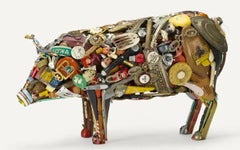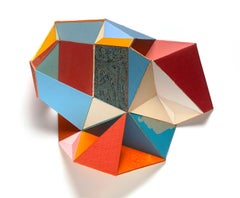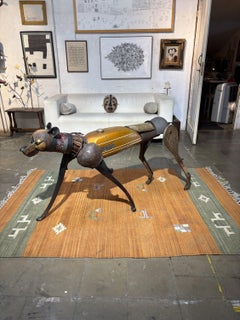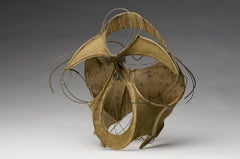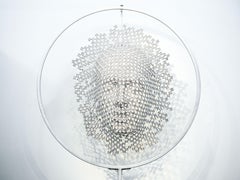Found Objects Sculptures
20th Century Folk Art Found Objects Sculptures
Found Objects
2010s Contemporary Found Objects Sculptures
Found Objects
21st Century and Contemporary Contemporary Found Objects Sculptures
Found Objects
2010s Street Art Found Objects Sculptures
Felt, Found Objects, Acrylic, Polymer
1980s Contemporary Found Objects Sculptures
Wire
2010s Contemporary Found Objects Sculptures
Metal, Steel, Stainless Steel
2010s Contemporary Found Objects Sculptures
Found Objects
2010s Contemporary Found Objects Sculptures
Concrete
21st Century and Contemporary Assemblage Found Objects Sculptures
Found Objects, Mixed Media
21st Century and Contemporary Contemporary Found Objects Sculptures
Wood, Paper, Varnish, Found Objects
2010s Contemporary Found Objects Sculptures
Concrete
21st Century and Contemporary Assemblage Found Objects Sculptures
Glass, Wood, Found Objects, Board, Acrylic
2010s Street Art Found Objects Sculptures
Wood, Found Objects, Oil, Spray Paint
2010s Contemporary Found Objects Sculptures
Felt, Linen, Found Objects, Mixed Media
21st Century and Contemporary Pop Art Found Objects Sculptures
Enamel
2010s Conceptual Found Objects Sculptures
Steel
21st Century and Contemporary Minimalist Found Objects Sculptures
Enamel
2010s Surrealist Found Objects Sculptures
Found Objects, Mixed Media
1990s Contemporary Found Objects Sculptures
Plaster, Wood, Paper, Found Objects, Newsprint
21st Century and Contemporary Naturalistic Found Objects Sculptures
Watercolor, Organic Material, Wood, Found Objects, Mixed Media
2010s Feminist Found Objects Sculptures
Fabric, Thread, Plaster, Dye, Found Objects
2010s Assemblage Found Objects Sculptures
Metal
2010s Assemblage Found Objects Sculptures
Metal
2010s Abstract Expressionist Found Objects Sculptures
Wood, Paint, Found Objects
2010s Assemblage Found Objects Sculptures
Metal
2010s Minimalist Found Objects Sculptures
Wood, Paint, Found Objects
21st Century and Contemporary Pop Art Found Objects Sculptures
Found Objects, Spray Paint, Wood Panel
21st Century and Contemporary Pop Art Found Objects Sculptures
Enamel
21st Century and Contemporary Pop Art Found Objects Sculptures
Enamel
21st Century and Contemporary Post-Modern Found Objects Sculptures
Plastic, Found Objects, Spray Paint, Wood Panel
21st Century and Contemporary Assemblage Found Objects Sculptures
Glass, Wood, Found Objects, Board, Resin, Spray Paint
2010s Found Objects Sculptures
Ceramic, Fabric, Wood, Found Objects
21st Century and Contemporary Abstract Expressionist Found Objects Sculptures
Canvas, Glass, Plastic, Paper, Oil, Found Objects
2010s Post-Minimalist Found Objects Sculptures
Plexiglass, Found Objects
21st Century and Contemporary Pop Art Found Objects Sculptures
Enamel
1980s Contemporary Found Objects Sculptures
Metal
2010s Feminist Found Objects Sculptures
Thread, Dye, Found Objects
21st Century and Contemporary Abstract Expressionist Found Objects Sculptures
Glass, Plastic, Paper, Found Objects, Cotton, Wood Panel
2010s Conceptual Found Objects Sculptures
Steel
2010s Conceptual Found Objects Sculptures
Steel
2010s Abstract Expressionist Found Objects Sculptures
Wood, Paint, Found Objects
2010s Contemporary Found Objects Sculptures
Metal, Wire
2010s Minimalist Found Objects Sculptures
Wood, Paint, Found Objects
2010s Abstract Geometric Found Objects Sculptures
Canvas, Wood, Found Objects, Acrylic
2010s Feminist Found Objects Sculptures
Ceramic, Fabric, Thread, Dye, Found Objects
1980s Contemporary Found Objects Sculptures
Metal
2010s Conceptual Found Objects Sculptures
Metal
2010s Feminist Found Objects Sculptures
Ceramic, Fabric, Thread, Dye, Found Objects
21st Century and Contemporary Abstract Geometric Found Objects Sculptures
Acrylic, Wood, Found Objects
2010s Conceptual Found Objects Sculptures
Wood, Video, Found Objects
2010s Conceptual Found Objects Sculptures
Steel
2010s Abstract Geometric Found Objects Sculptures
Canvas, Found Objects, Acrylic
2010s Abstract Expressionist Found Objects Sculptures
Wood, Paint, Found Objects
2010s Feminist Found Objects Sculptures
Fabric, Thread, Plaster, Dye, Found Objects
2010s Conceptual Found Objects Sculptures
Wire
2010s Conceptual Found Objects Sculptures
Photographic Film, Found Objects
2010s Conceptual Found Objects Sculptures
Pins, Organic Material, Plastic, Photographic Film, Acrylic Polymer, Fou...
2010s Post-Modern Found Objects Sculptures
Resin, Found Objects, Lights
21st Century and Contemporary Assemblage Found Objects Sculptures
Marble
21st Century and Contemporary Assemblage Found Objects Sculptures
Marble
Found Objects sculptures for sale on 1stDibs.
Read More
At Hosfelt Gallery, Bertoia Masterworks Complement Dynamic Contemporary Art
For nearly three decades, San Francisco–based Todd Hosfelt has curated against the grain — with a show on the legendary modernist Harry Bertoia the latest case in point.
This Weathered-Steel Sculpture Distills a Form of Protest into a Minimalist Monument
Part of Alejandro Vega Beuvrin’s “Barricada” series, the work is a subversive tribute to the street smarts of citizen activists.
How the Chunky, Funky Ceramics of 5 Mid-Century American Artists Balanced Out Slick Modernism
Get to know the innovators behind the pottery countercultural revolution.
Art Brings the Drama in These Intriguing 1stDibs 50 Spaces
The world’s top designers explain how they display art to elicit the natural (and supernatural) energy of home interiors.
Chryssa’s 1962 Neon Sculpture Was Way ahead of the Art-World Curve
By working with lettering, neon and Pop imagery, Chryssa pioneered several postmodern themes at a time when most male artists detested commercial mediums.
How to Spot a Fake KAWS Figure
KAWS art toys have developed an avid audience in recent decades, and as in any robust collectible market, counterfeiters have followed the mania. Of course, you don’t have to worry about that on 1stDibs, where all our sellers are highly vetted.
A Giant Wedding Cake Has Us Looking at Portuguese Tiles in a New Light
At Waddesdon Manor, artist Joana Vasconcelos has installed a three-tiered patisserie inspired by the narrative tile work of her homeland. We take a look at the cake sculpture and how Portuguese tiles have been used in architecture from the 17th century to today.
These Soft Sculptures Are Childhood Imaginary Friends Come to Life
Miami artist and designer Gabriela Noelle’s fantastical creations appeal to the Peter Pan in all of us.
